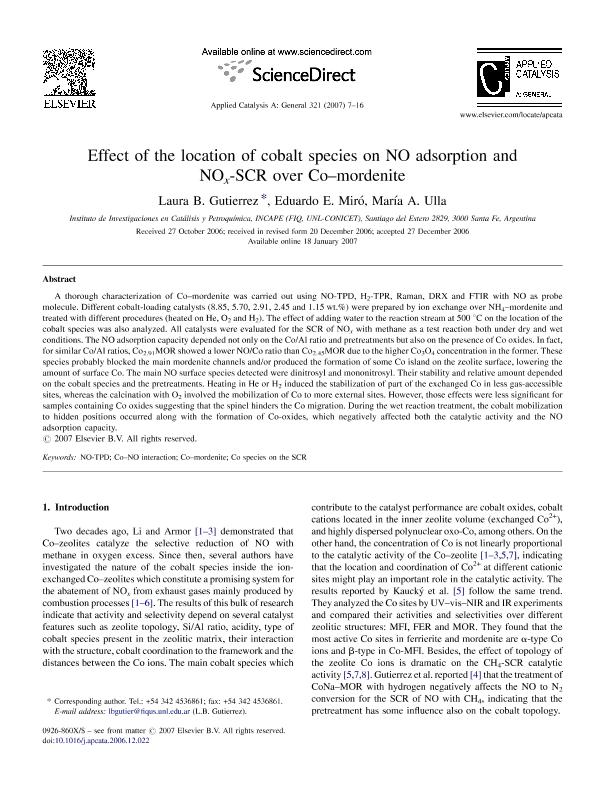Mostrar el registro sencillo del ítem
dc.contributor.author
Gutierrez, Laura Beatriz

dc.contributor.author
Miro, Eduardo Ernesto

dc.contributor.author
Ulla, Maria Alicia del H.

dc.date.available
2018-12-09T14:56:44Z
dc.date.issued
2007-03
dc.identifier.citation
Gutierrez, Laura Beatriz; Miro, Eduardo Ernesto; Ulla, Maria Alicia del H.; Effect of the location of cobalt species on NO adsorption and NOx-SCR over Co-mordenite; Elsevier Science; Applied Catalysis A: General; 321; 1; 3-2007; 7-16
dc.identifier.issn
0926-860X
dc.identifier.uri
http://hdl.handle.net/11336/66120
dc.description.abstract
A thorough characterization of Co-mordenite was carried out using NO-TPD, H2-TPR, Raman, DRX and FTIR with NO as probe molecule. Different cobalt-loading catalysts (8.85, 5.70, 2.91, 2.45 and 1.15 wt.%) were prepared by ion exchange over NH4-mordenite and treated with different procedures (heated on He, O2 and H2). The effect of adding water to the reaction stream at 500 °C on the location of the cobalt species was also analyzed. All catalysts were evaluated for the SCR of NOx with methane as a test reaction both under dry and wet conditions. The NO adsorption capacity depended not only on the Co/Al ratio and pretreatments but also on the presence of Co oxides. In fact, for similar Co/Al ratios, Co2.91MOR showed a lower NO/Co ratio than Co2.45MOR due to the higher Co3O4 concentration in the former. These species probably blocked the main mordenite channels and/or produced the formation of some Co island on the zeolite surface, lowering the amount of surface Co. The main NO surface species detected were dinitrosyl and mononitrosyl. Their stability and relative amount depended on the cobalt species and the pretreatments. Heating in He or H2 induced the stabilization of part of the exchanged Co in less gas-accessible sites, whereas the calcination with O2 involved the mobilization of Co to more external sites. However, those effects were less significant for samples containing Co oxides suggesting that the spinel hinders the Co migration. During the wet reaction treatment, the cobalt mobilization to hidden positions occurred along with the formation of Co-oxides, which negatively affected both the catalytic activity and the NO adsorption capacity.
dc.format
application/pdf
dc.language.iso
eng
dc.publisher
Elsevier Science

dc.rights
info:eu-repo/semantics/openAccess
dc.rights.uri
https://creativecommons.org/licenses/by-nc-sa/2.5/ar/
dc.subject
Co Species On the Scr
dc.subject
Co-Mordenite
dc.subject
Co-No Interaction
dc.subject
No-Tpd
dc.subject.classification
Otras Ingeniería Química

dc.subject.classification
Ingeniería Química

dc.subject.classification
INGENIERÍAS Y TECNOLOGÍAS

dc.title
Effect of the location of cobalt species on NO adsorption and NOx-SCR over Co-mordenite
dc.type
info:eu-repo/semantics/article
dc.type
info:ar-repo/semantics/artículo
dc.type
info:eu-repo/semantics/publishedVersion
dc.date.updated
2018-11-22T14:27:20Z
dc.journal.volume
321
dc.journal.number
1
dc.journal.pagination
7-16
dc.journal.pais
Países Bajos

dc.journal.ciudad
Amsterdam
dc.description.fil
Fil: Gutierrez, Laura Beatriz. Consejo Nacional de Investigaciones Científicas y Técnicas. Centro Científico Tecnológico Conicet - Santa Fe. Instituto de Investigaciones en Catálisis y Petroquímica ; Argentina
dc.description.fil
Fil: Miro, Eduardo Ernesto. Consejo Nacional de Investigaciones Científicas y Técnicas. Centro Científico Tecnológico Conicet - Santa Fe. Instituto de Investigaciones en Catálisis y Petroquímica ; Argentina
dc.description.fil
Fil: Ulla, Maria Alicia del H.. Consejo Nacional de Investigaciones Científicas y Técnicas. Centro Científico Tecnológico Conicet - Santa Fe. Instituto de Investigaciones en Catálisis y Petroquímica ; Argentina
dc.journal.title
Applied Catalysis A: General

dc.relation.alternativeid
info:eu-repo/semantics/altIdentifier/doi/http://dx.doi.org/10.1016/j.apcata.2006.12.022
Archivos asociados
